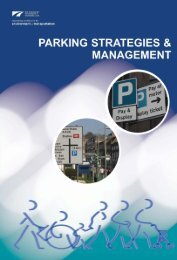Level 2 and 3 Diploma in Business Support (4475-12/13)
Level 2 and 3 Diploma in Business Support (4475-12/13)
Level 2 and 3 Diploma in Business Support (4475-12/13)
You also want an ePaper? Increase the reach of your titles
YUMPU automatically turns print PDFs into web optimized ePapers that Google loves.
called formal feedback. All staff <strong>in</strong> an organisation also has a responsibility for gather<strong>in</strong>g<br />
spontaneous customer feedback, eg chance remarks or comments, verbal or <strong>in</strong> writ<strong>in</strong>g made by<br />
customers without be<strong>in</strong>g asked. This is <strong>in</strong>formal feedback.<br />
2.6 If the service customers receive is consistently good, loyalty will be built. If there is a good<br />
background of achiev<strong>in</strong>g customer satisfaction, customer loyalty may exist but even when th<strong>in</strong>gs<br />
go wrong, organisations can recover from a bad situation with an <strong>in</strong>dividual customer by work<strong>in</strong>g<br />
on repair<strong>in</strong>g the damage. Repeat bus<strong>in</strong>ess is <strong>in</strong>fluenced by a customer’s on-go<strong>in</strong>g perception of<br />
the service they receive. Customer loyalty can be rewarded by mak<strong>in</strong>g special customer service<br />
arrangements <strong>and</strong> offers for repeat customers, eg po<strong>in</strong>ts programme; loyalty scheme; special<br />
offers.<br />
2.7 Customer relationships exist where customers do repeat bus<strong>in</strong>ess over time with the same<br />
organisation <strong>and</strong>/or service provider. Good customer relationships are important to a service<br />
provider because they build customer loyalty, result<strong>in</strong>g <strong>in</strong> repeat bus<strong>in</strong>ess. It is beneficial for an<br />
organisation to have loyal customers as it tends to be cheaper <strong>and</strong> easier to repeat bus<strong>in</strong>ess with<br />
an exist<strong>in</strong>g satisfied customer than it is to f<strong>in</strong>d a new customer.<br />
2.8 Know<strong>in</strong>g the ‘br<strong>and</strong>’ of the product or service is an important message to transmit to<br />
customers. A br<strong>and</strong> is a promise to customers. A strong br<strong>and</strong> name tells customers; ‘you know<br />
the name, you can trust the promise’. Generally there is a ‘logo’ <strong>and</strong> <strong>in</strong>stantly customers have a<br />
visual rem<strong>in</strong>der of what the company is offer<strong>in</strong>g <strong>and</strong> promis<strong>in</strong>g customers <strong>and</strong> they know what to<br />
expect. Customers can be attracted to the br<strong>and</strong> above that of the competition.<br />
Outcome 3 Underst<strong>and</strong> pr<strong>in</strong>ciples of respond<strong>in</strong>g to customers’ problems<br />
or compla<strong>in</strong>ts<br />
3.1 Customer problems <strong>and</strong> compla<strong>in</strong>ts can be caused through eg faulty goods, poor quality,<br />
<strong>in</strong>correct stock, failure to return calls, failure to meet deadl<strong>in</strong>es, poor attitude of staff.<br />
3.2 The most effective methods of communication are eg<br />
• face-to-face<br />
• written communication eg letter, email<br />
• telephone <strong>and</strong> text<br />
Face-to-face – is about eye contact <strong>and</strong> active listen<strong>in</strong>g. ‘Normal’ eye contact may differ across<br />
cultures; ‘active listen<strong>in</strong>g’ is about head nodd<strong>in</strong>g, gestures <strong>and</strong> repeat<strong>in</strong>g back phrases that are<br />
heard <strong>and</strong> confirmation of underst<strong>and</strong><strong>in</strong>g.<br />
Written communication is eg letter, email, memos <strong>and</strong> reports. There will be guidel<strong>in</strong>es on when<br />
<strong>and</strong> how to use written communication eg house styles, language to be used etc. Written<br />
communication will be necessary when a formal response is required.<br />
Telephone communication requires be<strong>in</strong>g able to operate the equipment efficiently <strong>and</strong><br />
effectively; mak<strong>in</strong>g sure customers are regularly <strong>in</strong>formed when the service deliverer is access<strong>in</strong>g<br />
<strong>in</strong>formation to provide responses, or if they are go<strong>in</strong>g to be on hold, etc; speak<strong>in</strong>g clearly <strong>and</strong><br />
slowly to allow for the possibility that reception on the ‘phone l<strong>in</strong>e may not be perfect; adapt<strong>in</strong>g<br />
speech to meet <strong>in</strong>dividual needs of customer.<br />
3.3 It is important to adapt methods of communication to meet the <strong>in</strong>dividual needs of a range of<br />
customers for example those with:<br />
• language difficulties<br />
• health issues<br />
• different age groups<br />
• cultural differences<br />
• learn<strong>in</strong>g difficulties<br />
<strong>Level</strong> 2 <strong>and</strong> 3 <strong>Diploma</strong> <strong>in</strong> Bus<strong>in</strong>ess <strong>Support</strong> (<strong>4475</strong>-<strong>12</strong>/<strong>13</strong>) 91







